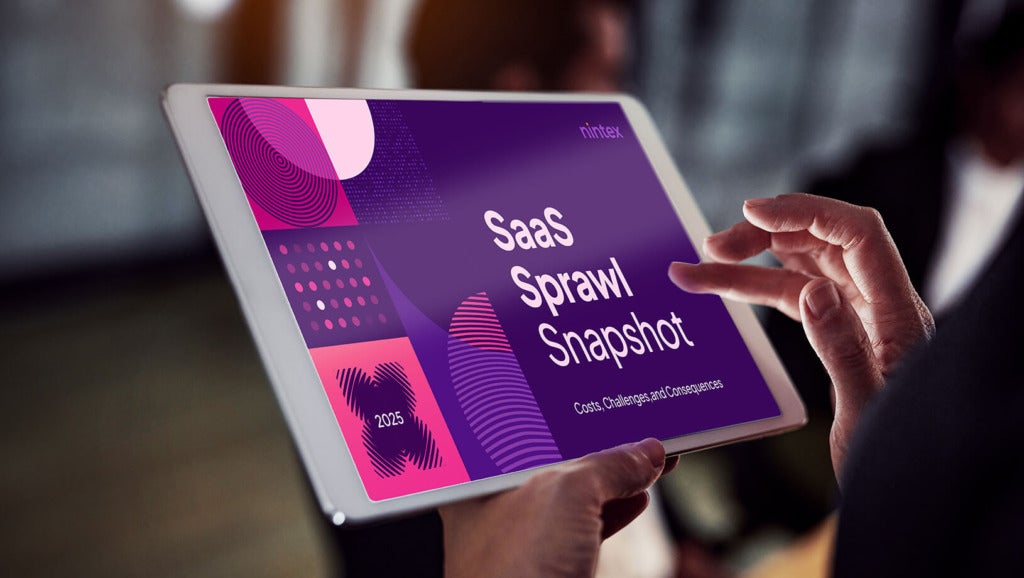Operations leaders are well-acquainted with the pain of SaaS sprawl — the monthly bills that keep climbing, the confusion when important data gets trapped in separate systems, and the frustration of jumping between dozens of tools that don’t talk to each other. Not to mention the many security blind spots that keep CISOs up at night.
But what if there was a cure for this modern corporate plague? What if your efforts to combat SaaS sprawl stopped being a one-off cleanup project and became an integral piece of your company’s operations?
We believe it’s possible to build a culture where thoughtful software selection becomes the norm, not the exception. To dig deeper, we talked to Jay Tomlin, Nintex’s Senior Director of Product Management, about how operations leaders can create and maintain an anti-SaaS sprawl environment that controls costs, improves data sharing and communication, and empowers teams to do their best work.

3 characteristics of an anti-SaaS sprawl organization
Achieving this kind of streamlined SaaS profile starts with a strong strategic foundation — one built on clear, intentional practices. Here are three core pillars of a successful anti-SaaS sprawl approach:
1. Your company has leadership buy-in and advocacy
Tackling SaaS sprawl requires commitment from the executive suite, particularly from financial and technology leaders. Collectively, the CFO, CIO, and CTO can champion and drive anti-sprawl initiatives throughout the organization.
“It starts with the CFO and CIO asking, ‘What’s our current SaaS spend, and what should we bring it down to?’” says Tomlin. “From there, the CIO takes charge of understanding the full application inventory and driving the reduction.”
The CTO aligns the technical strategy with these cost-control efforts, ensuring that any changes to the software stack maintain performance, security, and scalability. They also help evaluate how to adapt and integrate existing tools more efficiently.
While input from other leadership roles matters, these three executives have the authority and technical understanding to implement meaningful change. Their visible advocacy — from celebrating teams that reduce redundant tools to leading teams focused on software governance — sends a clear message that controlling SaaS sprawl is a strategic priority.
2. Your company tracks and targets SaaS spend metrics
Forward-thinking organizations set clear, measurable goals for SaaS expenditure per employee and communicate them openly to all internal teams.
“Once the target is stated out loud, the whole company can align around it,” explains Tomlin. “Enforcement happens mainly through the budget: ‘Last year we spent X on SaaS, which equals Y per employee; next year we’ll cut that by Z percent.’”
Organizations can achieve these reduction targets through structured approval workflows, regular usage audits, and incentive programs that reward departments for meeting their SaaS spend goals. As these methods take hold, they give leaders clearer visibility into spending patterns and usage inefficiencies.
By tying software costs directly to headcount, leaders gain a clearer sense of scale — and where things might be getting bloated. It also creates accountability across teams, since they have to justify any new software request within a shared, company-wide benchmark.
3. Your company is willing to slow down to go faster
It’s tempting to say yes to every new tool promising to solve an immediate problem, boost productivity, or eliminate friction in a specific workflow. But teams often chase these short-term wins and quick fixes without considering long-term implications for the broader tech ecosystem.
“Tightening controls may feel slow now, but the benefits compound over time,” says Tomlin. “Letting SaaS sprawl continue is the opposite: it feels fast and easy at first, yet you eventually end up with dozens of apps per employee, tangled integrations, and hidden costs that surface later.”
A deliberate approach to SaaS acquisition requires patience and discipline. But by pausing to evaluate your true organizational needs, vet vendors carefully, and align purchases with business goals, your organization can build a more sustainable and cost-effective ecosystem.
How to become an anti-SaaS-sprawl organization
With a little upfront effort and planning, any company can achieve a more streamlined, cost-effective tech stack enabling greater transparency, efficiency, and communication across its day-to-day operations. Here’s how to create a practical roadmap that works with your existing structure, not against it:
1. Set up procurement safeguards
Your initial line of defense against SaaS sprawl is creating a structured approval process for software purchases. This doesn’t have to be complicated, but it does need to be consistent.
“The first step is to set up a workflow — something Nintex can handle easily — that adds a standardized approval process before any new SaaS app is purchased or renewed,” says Tomlin. “A common approach is to require VP-level sign-off before procurement or integration. That’s the quickest way to impose a constraint and make spending easier to track.”
Will this slow things down a bit? Yes — and that’s actually the point. Without this speed bump, teams buy what they want, when they want, which is exactly how SaaS sprawl happens in the first place. The key is finding the right balance between control and efficiency so your teams can still get their work done without too much unnecessary friction.
2. Audit your tools to see what people regularly use
Don’t just count your SaaS subscriptions — measure how actively they’re being used. Regular audits help you spot underutilized tools that drain your budget without delivering value.
“The key metric is adoption,” explains Tomlin. “Any SaaS platform should show which employees are active weekly and monthly. I manage a few tools at Nintex, and because licenses are pricey, I regularly ask: ‘Are our paid users actually using this?’ If someone hasn’t logged in for six months, they lose their seat and we stop paying.”
Pay special attention to how customizable your tools are. If employees start creating workarounds or using spreadsheets instead of your expensive software, it’s a red flag that the tool isn’t meeting their evolving needs.
3. Standardize onboarding and communication around tool usage
Clear communication about your existing SaaS stack is just as important as controlling new purchases. When employees don’t know what software or features they already have access to, they’ll naturally look elsewhere for solutions — creating the perfect conditions for tech sprawl.
“Sometimes people don’t even know a tool exists, even though they’re supposed to be using it,” says Tomlin. “Take the recorder on a Zoom call. A lot of companies have that feature, but if you don’t even know it exists, you might end up buying a separate tool to do the same thing. The breakdown here is that the tool was available at the company — but nobody told you.”
Make tool awareness a standard part of your employee onboarding process. Create a simple catalog of available software that clearly explains what each tool does, who should use it, and how to get access. When you add new software to your stack, announce it company-wide.
This approach tackles two problems at once: It increases usage of your existing investments while preventing duplicate purchases that contribute to sprawl.
The best part? Unlike procurement controls, better communication creates almost no friction — it just helps people make smarter choices with the resources they already have.
4. Make lowering SaaS spend a company-wide incentive
Turning SaaS cost reduction into a shared goal helps shift your software procurement culture away from tool hoarding and toward thoughtful resource management. The key is to strike the right note between accountability and encouragement.
“You can use the carrot and stick approach,” suggests Jay Tomlin. “The stick is strict budget control: ‘You’re spending $1,000 per employee each month — cut that to $500 or the tool won’t be renewed unless you prove it’s essential.’ The carrot is an incentive program: if a team lowers its SaaS spend, it earns extra discretionary funds elsewhere.”
Consider creating friendly competition between departments with quarterly recognition for teams that make the biggest improvements in reducing unnecessary software costs. When you celebrate these wins publicly, you reinforce that managing SaaS sprawl is a valued contribution to the company’s success — not just an IT or finance directive.
Remember that the goal isn’t to create a culture of scarcity, but rather one of intentionality. When teams feel ownership over their software decisions and see the benefits of streamlining, they become active participants in solving the sprawl problem rather than resisting control measures.
Stop SaaS sprawl to build a leaner, smarter organization
Building an anti-SaaS-sprawl organization won’t happen overnight. But with clear spending targets, leadership buy-in, and the right mix of controls and incentives, you can transform your company’s approach to software acquisition and adoption. And when employees understand both the tools at their disposal and why sprawl matters, they become allies in keeping your tech stack lean and effective.
Ready to take the first step? Nintex helps organizations streamline workflows and gain visibility into their software usage. Our process management platform can implement approval processes and tracking systems to prevent sprawl before it starts.
To uncover more about how SaaS sprawl is impacting organizations around the globe, Nintex surveyed 2,000 IT decision-makers across Australia, the United Arab Emirates (UAE), the United Kingdom, and the United States. Check out the SaaS Sprawl Snapshot 2025 and find out how IT teams are simplifying their stacks and saving costs — without slowing down innovation.


